Historic City of Ahmedabad, Gujarat
Been there recently?
Ahmedabad, with the Sabarmati River running through its centre, is one of the largest cities of India and the former capital of Gujarat. Also called Amdavad, it is known for its world-famous cotton textiles, a wide variety of mouth-watering snacks, diamond cutting, and much more. Declared as India’s first UNESCO World Heritage City, it is steeped in history and tradition. Gujarat’s largest city is a bustling cosmopolitan hub that offers a seamless fusion of magnificent architecture from centuries-old mosques and cutting-edge contemporary design. The Sabarmati river splits the city in two, dividing each half into separate sections. The sprawling new town, which has carved out a niche for itself with top-notch urban planning, is located on the western bank of the river, while the charming old quarter is located on the eastern bank and is distinguished by winding lanes marked by tradition and culture. Ahmedabad transforms into a tourist hotspot where one would be spoilt for choice when you combine this with a diverse selection of street food and vibrant bazaars. While Gandhinagar, Ahmedabad’s twin city, now serves as the state capital, Ahmedabad still houses the Gujarat High Court and is the state’s financial hub. Ahmedabad served as Gujarat’s capital from 1960 to 1970. Mahatma Gandhi established his Sabarmati Ashram in this city, making it a focal point of India’s fight for independence from British rule. Ahmedabad has been dubbed “Manchester of the East” due to the city’s successful textile industry, which has helped propel it into the modern era. Navratri is a cultural and spiritual extravaganza, and the city is famous for its grandiose celebrations of the festival.
Nearby Places to See
Heritage Walk
Ahmedabad is a city with a rich heritage dating back 600 years. Many people travel to the city to see the impressive Hindu and Jain temple architecture and Indian-Islamic buildings. The region’s distinctive custom of constructing elaborately carved wooden homes has won widespread acclaim. Going on a heritage walk is a great way to learn about the city and its history. The walk begins at Swaminarayan Temple in Kalupur and takes in many of the city’s top sights.
Ahmedabad is a city with a rich heritage dating back 600 years. Many people travel to the city to see the impressive Hindu and Jain temple architecture and Indian-Islamic buildings. The region’s distinctive custom of constructing elaborately carved wooden homes has won widespread acclaim. Going on a heritage walk is a great way to learn about the city and its history. The walk begins at Swaminarayan Temple in Kalupur and takes in many of the city’s top sights.
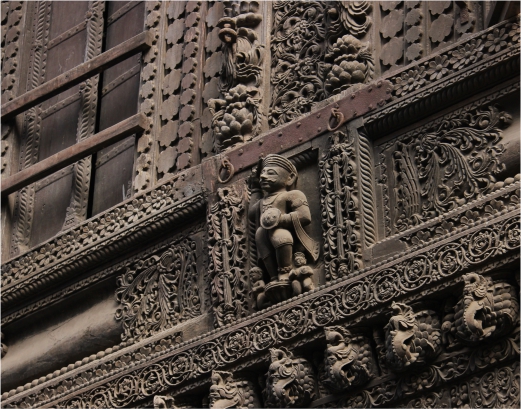
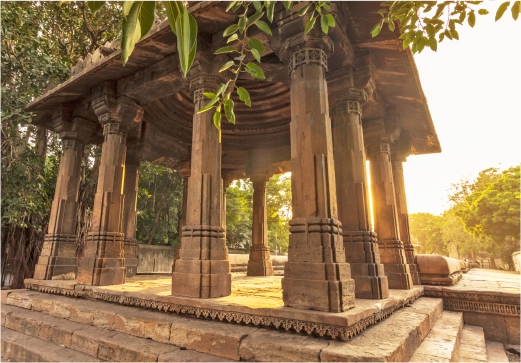
Bai Hari Ni Vav
It is a beautifully constructed step well that was built in the Asarwa neighbourhood of the city in 1499 by Bai Harir Sultani under the direction of Muhammed Shah Begada of the Gujarat Sultanate. She oversaw the Sultan’s harem and built this step well with funds she personally deposited over the years. The octagonal-shaped, five-storeyed deep well has outlets for the water to flow out at each level.
It is a beautifully constructed step well that was built in the Asarwa neighbourhood of the city in 1499 by Bai Harir Sultani under the direction of Muhammed Shah Begada of the Gujarat Sultanate. She oversaw the Sultan’s harem and built this step well with funds she personally deposited over the years. The octagonal-shaped, five-storeyed deep well has outlets for the water to flow out at each level.
Shree Swaminarayan Temple
This is the first temple of the Swaminarayan sect, built on land given as compensation by the British government after the temple gave up its land to build a railroad station. The temple was inaugurated in 1822. It is an example of the prevalent architecture of the 19th century. The intricate carvings on the door jambs and in the wood represent the craftsmanship of the period.
This is the first temple of the Swaminarayan sect, built on land given as compensation by the British government after the temple gave up its land to build a railroad station. The temple was inaugurated in 1822. It is an example of the prevalent architecture of the 19th century. The intricate carvings on the door jambs and in the wood represent the craftsmanship of the period.
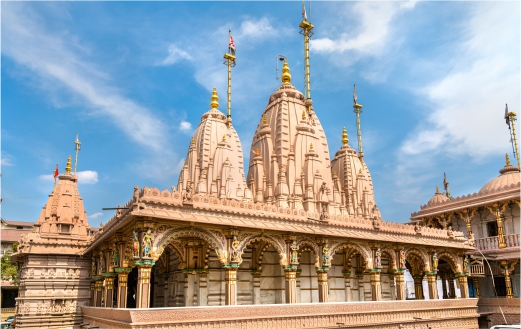
Kankaria Lake
The length of Kankaria Lake is close to 2 kilometres, and its area is close to 76 acres, making it an artificial lake with a polygonal shape. There are several sloping entry points around the lake, and the stone steps that encircle it. Square cupolas, each supported by 12 pillars, are placed atop these sloping roofs. The Naginavadi Island, constructed there, serves as the lake’s focal point. A zoo, a natural history museum, a toy train, a children’s garden called Bal Vatika, an outdoor theatre, a balloon safari, and high-speed train rides are some of the additional amenities. Because it has so much to offer, the lake has steadily grown in popularity among visitors as a one-stop entertainment hub.
The length of Kankaria Lake is close to 2 kilometres, and its area is close to 76 acres, making it an artificial lake with a polygonal shape. There are several sloping entry points around the lake, and the stone steps that encircle it. Square cupolas, each supported by 12 pillars, are placed atop these sloping roofs. The Naginavadi Island, constructed there, serves as the lake’s focal point. A zoo, a natural history museum, a toy train, a children’s garden called Bal Vatika, an outdoor theatre, a balloon safari, and high-speed train rides are some of the additional amenities. Because it has so much to offer, the lake has steadily grown in popularity among visitors as a one-stop entertainment hub.
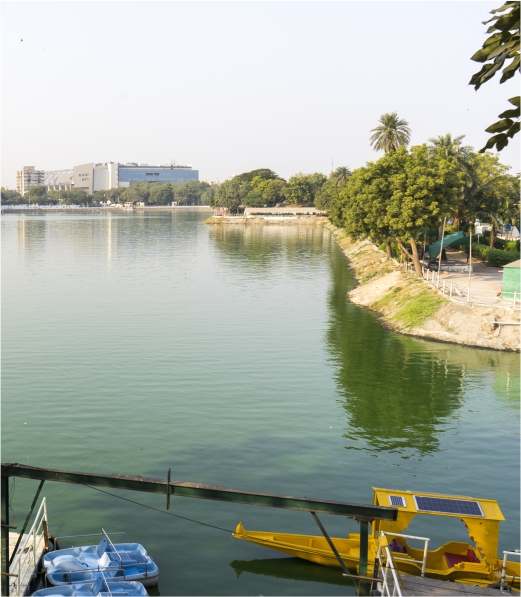
Gandhi Ashram
Sabarmati Gandhi Ashram served as the focal point of Mahatma Gandhi’s nonviolent fight for India’s independence from the British. One can go back in time to get a sense of his philosophy and remarkable life because his aura still hangs around here. A large collection of letters written by Gandhi, many of which were written on scraps of used paper, are kept in a library dedicated to his writings. In addition to Hridaykunj, the ashram also has access to Vinoba-Mira Kutir, a guest house, a prayer area, and a structure that serves as a training facility for cottage industries.
Sabarmati Gandhi Ashram served as the focal point of Mahatma Gandhi’s nonviolent fight for India’s independence from the British. One can go back in time to get a sense of his philosophy and remarkable life because his aura still hangs around here. A large collection of letters written by Gandhi, many of which were written on scraps of used paper, are kept in a library dedicated to his writings. In addition to Hridaykunj, the ashram also has access to Vinoba-Mira Kutir, a guest house, a prayer area, and a structure that serves as a training facility for cottage industries.
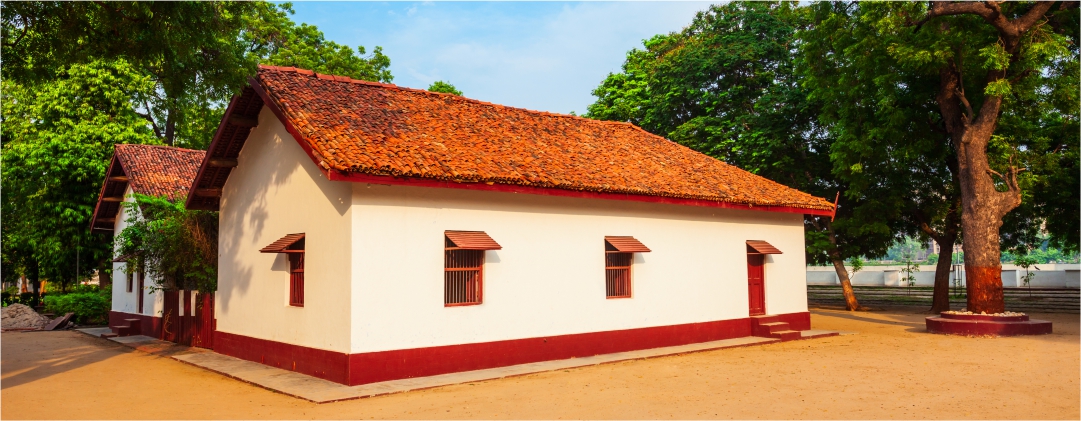


-
Destination



